Design Principle of RF Stealth Anti-Sorting Signal Based on Multi-Dimensional Compound Modulation with Pseudo-Center Width Agility
Abstract
:1. Introduction
2. Clustering Algorithms
2.1. K-Means Clustering Algorithm Based on Data Fields
2.2. Fuzzy Clustering Algorithms
3. Design Principle of Anti-Cluster-Sorting Signal Based on Multi-Dimensional Pseudo-Center Width Agility
3.1. Failure Principle of K-Means Clustering Based on Data Fields
3.1.1. Euclidean Distance Measures Pulse Similarity
3.1.2. Minkowsky Distance Measures Pulse Similarity
3.2. Failure Principle of FCM Clustering and Sorting
3.2.1. Euclidean Distance Measures Pulse Similarity
3.2.2. Minkowsky Distance Measures Pulse Similarity
3.3. Signal Design Principles
4. Signal Simulation Verification and Experiment
4.1. Simulation Verification of Signal Design Principle
4.1.1. Simulation Verification of K-Means Clustering Based on the Data Field
4.1.2. Simulation Verification of FCM Clustering
4.2. Comparison Simulation with Random Interference Pulse Anti-Sorting Signal
4.2.1. Comparative Simulation of K-Means Clustering Algorithm Based on Data Field for Signal Sorting
4.2.2. Comparison Simulation of Signal Sorting Based on Margin
4.3. Contrast Experiment of Signal Sorting Based on Experimental System
4.3.1. Introduction to Experimental System
4.3.2. Sorting Contrast Experiment
5. Conclusions
Author Contributions
Funding
Data Availability Statement
Conflicts of Interest
Appendix A
References
- Jia, J.; Han, Z.; Liang, Y.; Liu, L.; Wang, X. Design of Multi-Parameter Compound Modulated RF Stealth Anti-Sorting Signals Based on Hyperchaotic Interleaving Feedback. Entropy 2022, 24, 1283. [Google Scholar] [CrossRef] [PubMed]
- Jia, J.W.; Liu, L.M.; Han, Z.Z.; Xie, H. A survey on waveform design technology of RF stealth radar. Electron. Opt. Control 2022, 29, 57–64+78. [Google Scholar]
- Zhao, X.T.; Zhou, J.J. Improved MUSIC algorithm for MIMO radar with low intercept. Syst. Eng. Electron. 2022, 44, 490–497. [Google Scholar]
- Sun, Y.B. Low probability of intercept waveform with rejection capability of spread spectrum parameter measurements. Telecommun. Eng. 2021, 61, 821–826. [Google Scholar]
- Chang, W. Design of synthetic aperture radar low-intercept radio frequency stealth. J. Syst. Eng. Electron. 2020, 31, 64–72. [Google Scholar] [CrossRef]
- Yang, Y.X.; Wang, D.X.; Huang, Q. Design Method of Radio Frequency Stealth Frequency Hopping Communications Based on Four-Dimensional Hyperchaotic System. J. Astronaut. 2020, 41, 1341–1349. [Google Scholar]
- Fan, Y.C. Research on RF Stealth Waveform Design of Airborne Battlefield Surveillance Radar; China Academic of Electronics and Information Technology: Beijing, China, 2021. [Google Scholar]
- Liu, L.T.; Wang, L.L.; Chen, T. Non-parametric radar signal sorting algorithm based on improved DSets. Chin. J. Ship Res. 2021, 16, 232–238. [Google Scholar]
- Sui, J.P.; Liu, Z.; Liu, L.; Li, X. Progress in radar emitter signal deinterleaving. J. Radars 2022, 11, 418–433. [Google Scholar]
- Jiang, Z.Y.; Sun, S.Y.; Li, H.W.; Guang, L. A method for deinterleaving based on JANET. J. Univ. Chin. Acad. Sci. 2021, 38, 825–831. [Google Scholar]
- Jia, J.; Han, Z.; Liu, L.; Xie, H.; Lv, M. Research on the Sequential Difference Histogram Failure Principle Applied to the Signal Design of Radio Frequency Stealth Radar. Electronics 2022, 11, 2192. [Google Scholar] [CrossRef]
- Jia, J.; Han, Z.; Liu, L.; Xie, H.; Lv, M. Research on the SDIF Failure Principle for RF Stealth Radar Signal Design. Electronics 2022, 11, 1117. [Google Scholar] [CrossRef]
- Yu, Q.; Bi, D.P.; Chen, L. Jamming Technology of Research Based on PRI Parameter Separation of Signal to ELINT System. Fire Control. Command. Control. 2016, 41, 143–147. [Google Scholar]
- Dai, S.B.; Lei, W.H.; Cheng, Y.Z. Electronic Anti-Reconnaissance Based on TOA Analysis. Electron. Inf. Warf. Technol. 2014, 29, 4. [Google Scholar]
- Wang, F.; Liu, J.F. LPS design of pulse repetition interval for formation radars. Inf. Technol. 2019, 3, 14–18+23. [Google Scholar]
- Nan, H.; Peng, S.; Yu, J.; Wang, X. Pulse interference method against PRI sorting. J. Eng. 2019, 2019, 5732–5735. [Google Scholar] [CrossRef]
- Sun, Z.Y.; Jiang, Q.X.; Bi, D.P. A technology for anti-reconnaissance based on factional quasi orthogonal waveform. Mod. Radar 2015, 37, 7. [Google Scholar]
- Zhang, B.Q.; Wang, W.S. Anti-Clustering Analysis of Anti-Reconnaissance Based on Full Pulse Information Extraction. Electron. Inf. Warf. Technol. 2017, 32, 19–25. [Google Scholar]
- Wang, W.S.; Ban, X.D.; Long, X.B. Research on Count-Reconnaissance of Emitters Based on Ant- ISODATA Clustering Analysis. Electron. Inf. Warf. Technol. 2012, 27, 41–45+68. [Google Scholar]
- Chen, J.; Wang, Y.; Li, J.; Long, W. Tensor Decomposition and K⁃means Clustering Based Array Diagnosis for MIMO Radar in Impulsive Noise Environment. Acta Electron. Sin. 2021, 49, 2315–2322. [Google Scholar]
- Hou, F.; Yao, Z.; Yang, J.; Li, Y.; Wang, Z. A fast detection method of frequency hopping signal based on K-means clustering. Telecommun. Eng. 2022, 62, 199–205. [Google Scholar]
- Yang, L. Radio sorting and recognition technology based on K-means clustering for subtle features. Telecommun. Eng. 2022, 62, 1149–1154. [Google Scholar]
- Gao, Y.; Yang, C.; Wang, Z.; Luo, S.; Pan, J. Robust Fuzzy C-means Clustering Algorithm Integrating Between-cluster Information. J. Electron. Inf. Technol. 2019, 41, 1114–1121. [Google Scholar]
- Huang, C. Analysis of Typical Cluster Methods in Radar Signal Sorting. Electron. Inf. Warf. Technol. 2017, 32, 1–4+62. [Google Scholar]
- Guo, J.; Chen, J. Clustering approach for deinterleaving unknown radar signals. Syst. Eng. Electron. 2006, 28, 853–863. [Google Scholar]
- Peng, G.; Yuan, X.; Liu, W. A Survey of Clustering and Sorting Algorithms for Radar Source Signals. Radar Sci. Technol. 2019, 17, 485–492. [Google Scholar]
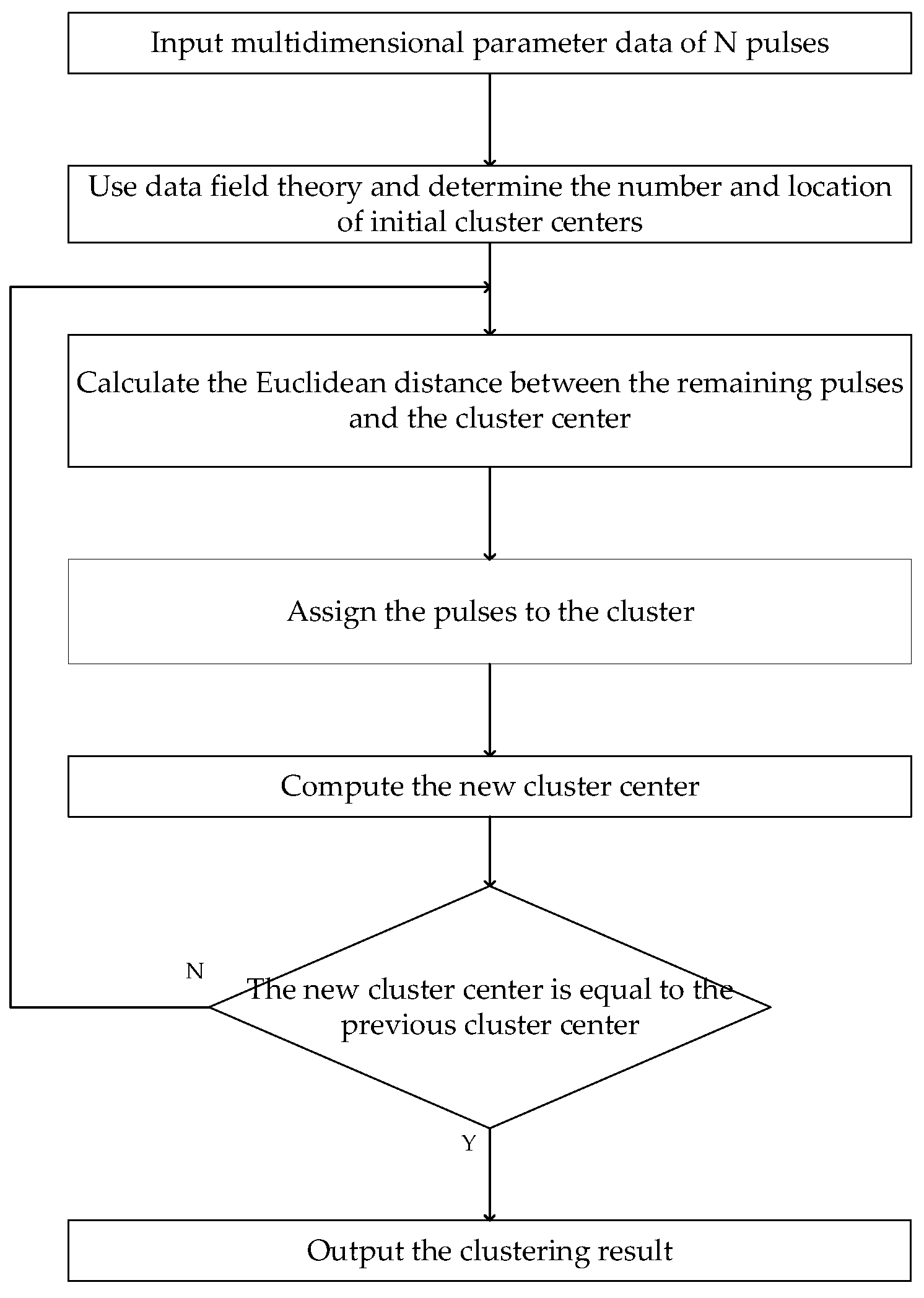
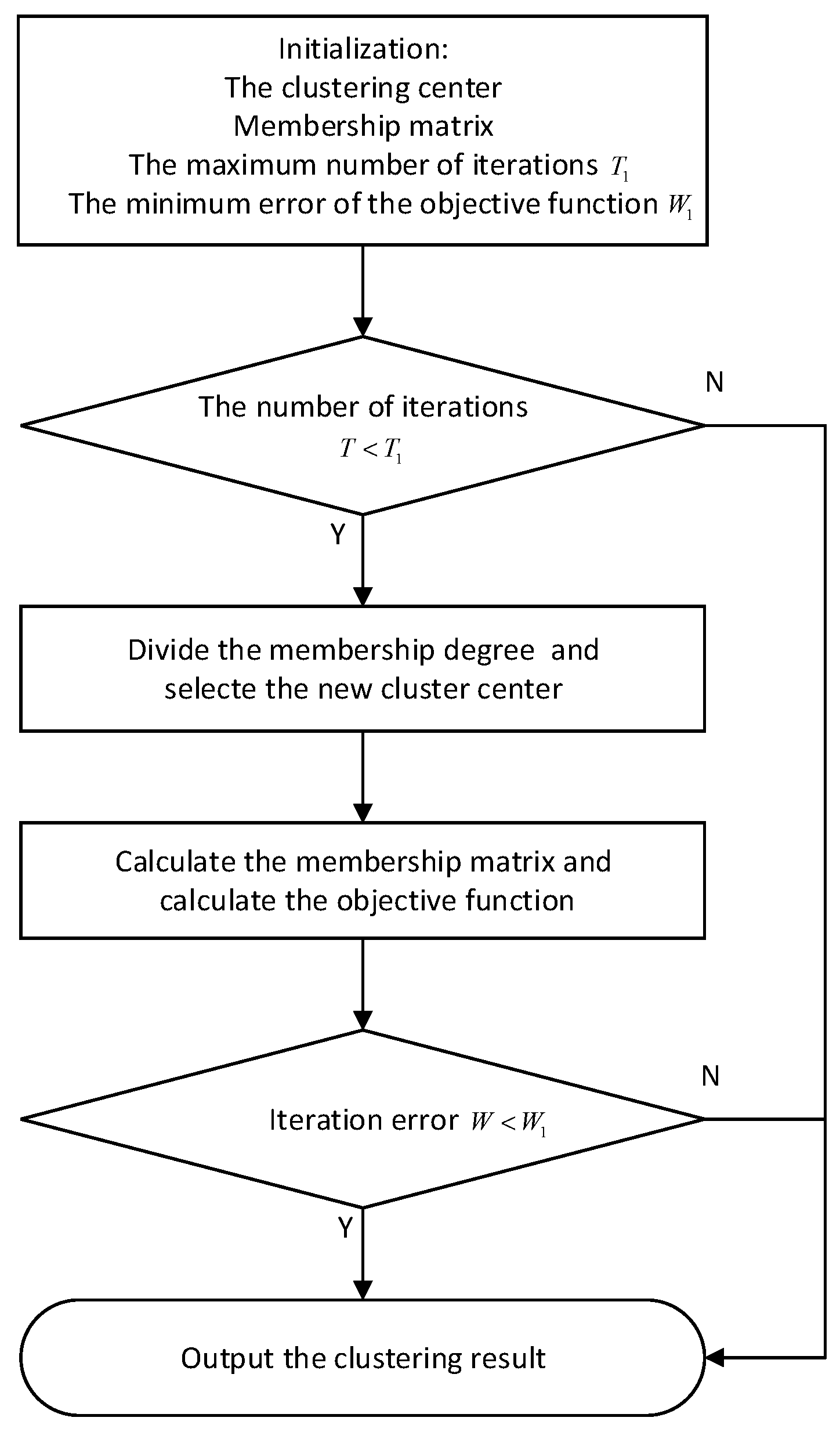
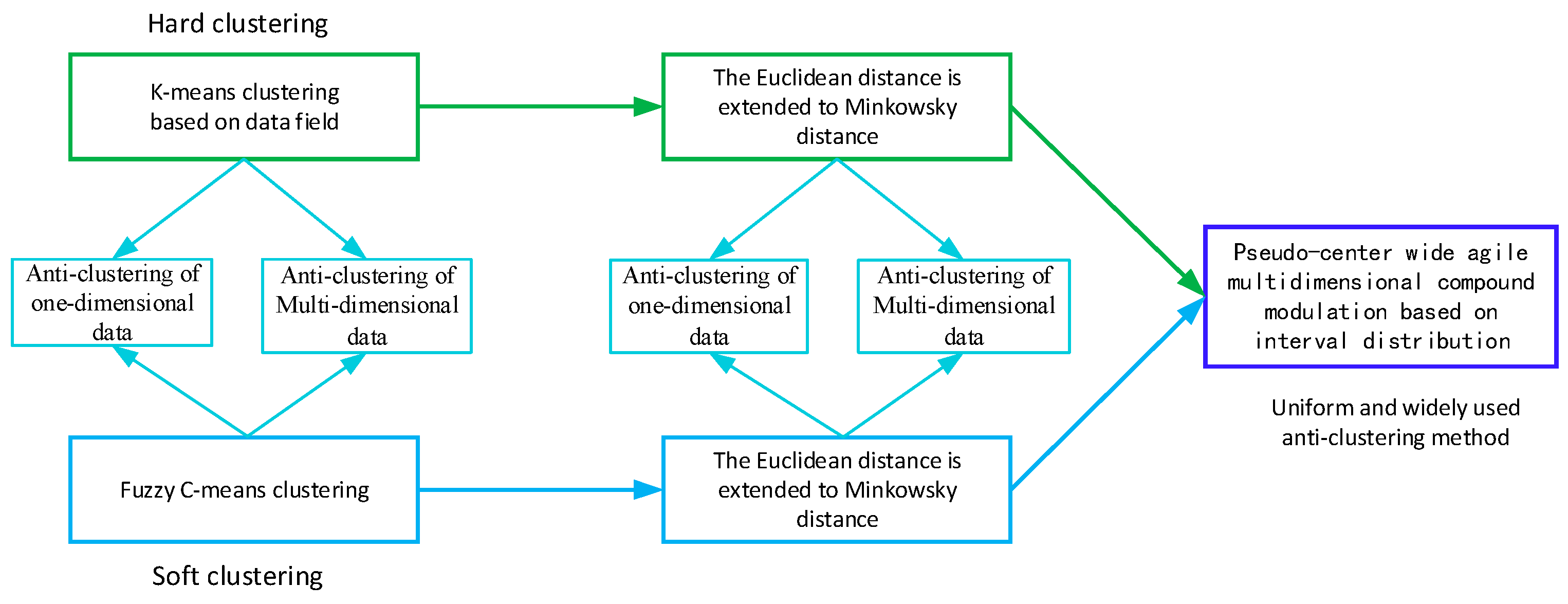
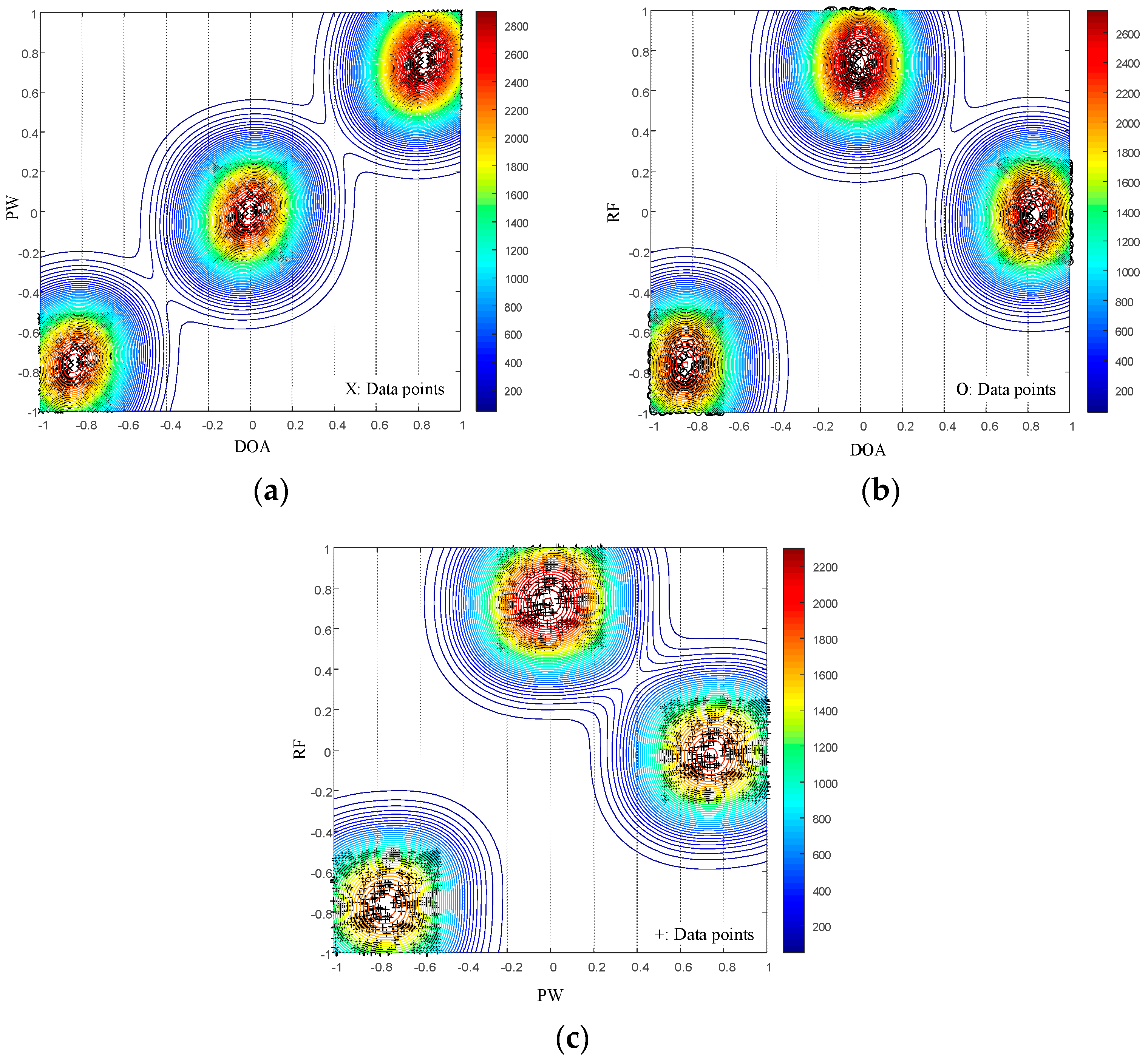
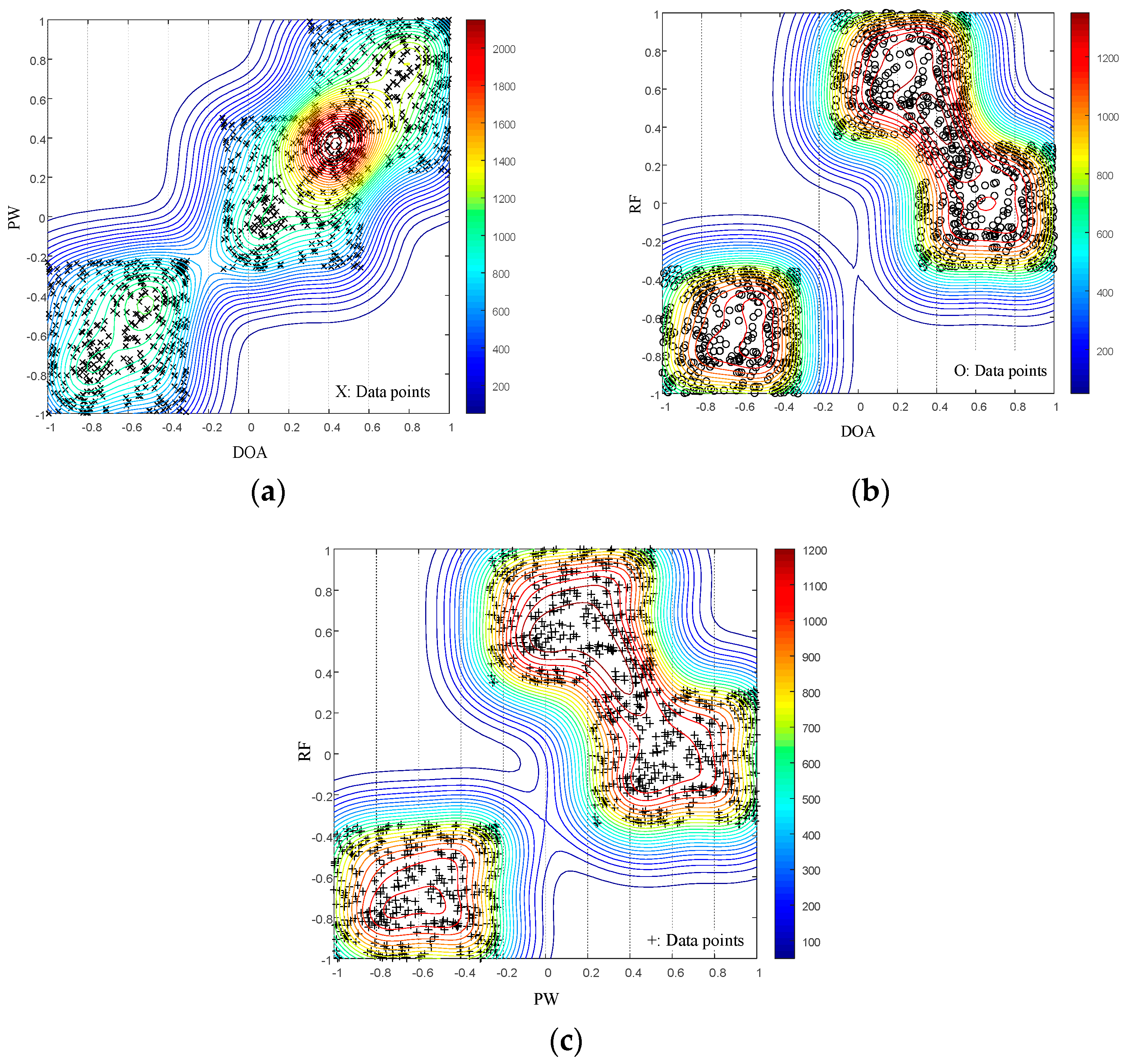
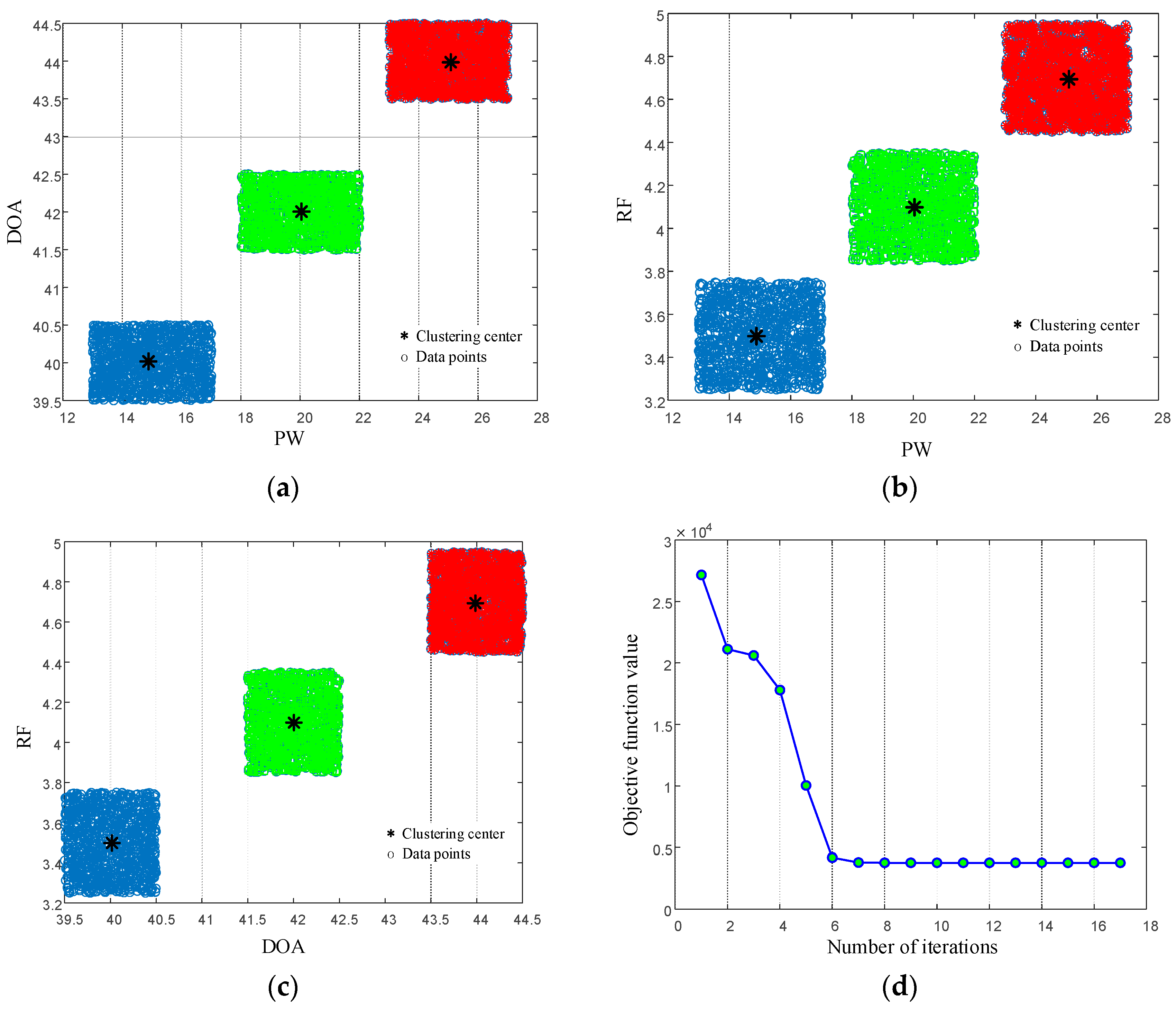

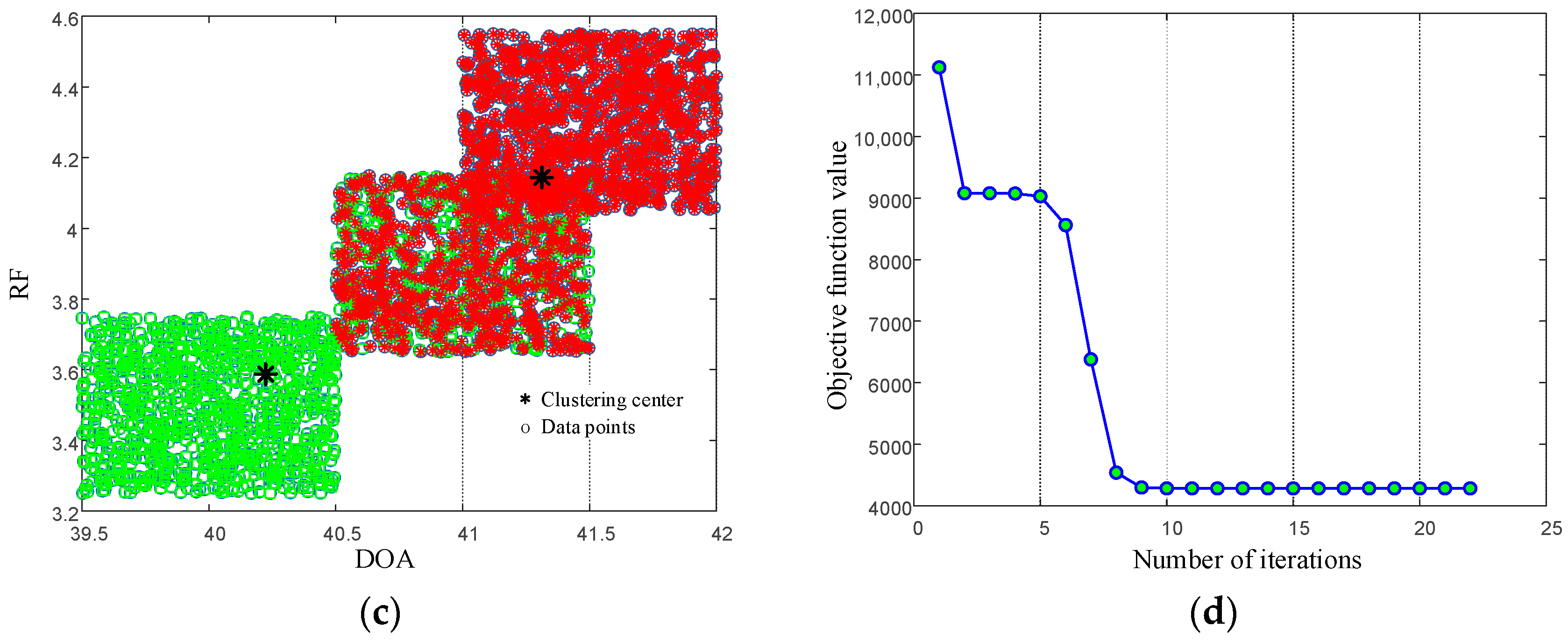




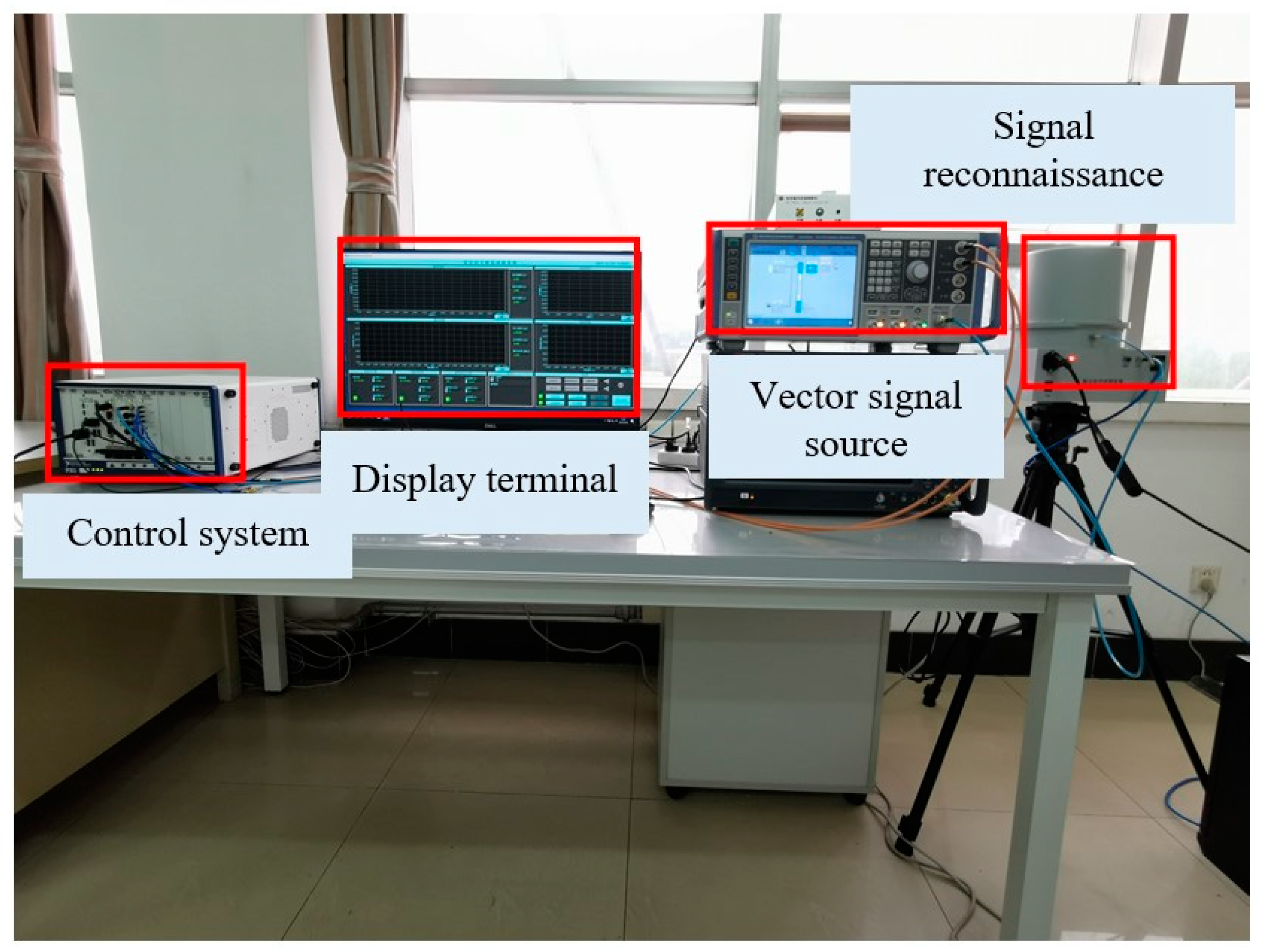


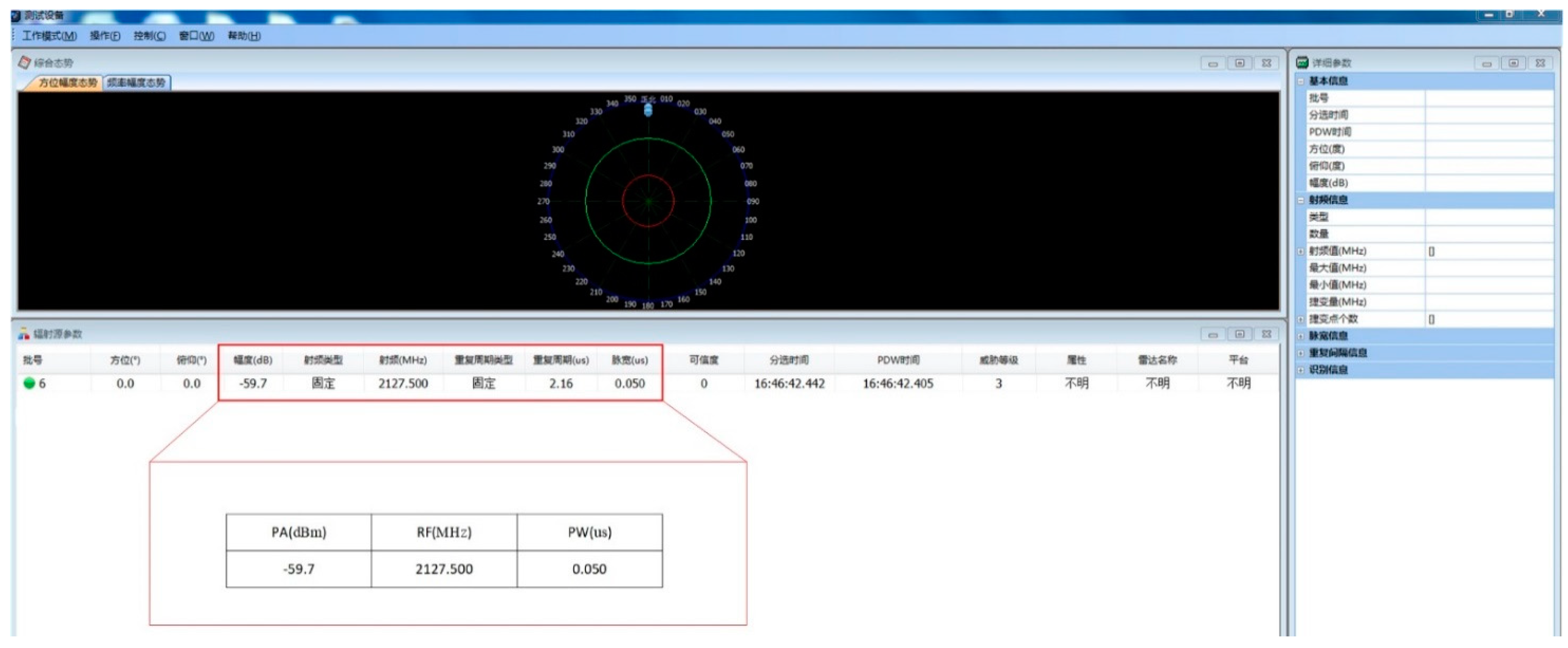
| Serial Number | Parameter Type | Center Value with Wide-Interval Agility | Center Value without Wide-Interval Agility | ||||
|---|---|---|---|---|---|---|---|
| Center Value | Parameter Variation Interval | Interval Length | Center Value | Parameter Variation Interval | Interval Length | ||
| 1 | PW | ||||||
| 2 | |||||||
| 3 | |||||||
| 4 | DOA | ||||||
| 5 | |||||||
| 6 | |||||||
| 7 | RF | 3.5 GHz | 0.5 GHz | 3.5 GHz | 0.5 GHz | ||
| 8 | 4.1 GHz | 0.5 GHz | 3.9 GHz | 0.5 GHz | |||
| 9 | 4.7 GHz | 0.5 GHz | 4.3 GHz | 0.5 GHz | |||
| Serial Number | Parameter Type | Center Value with Wide-Interval Agility | ||
|---|---|---|---|---|
| Center Value | Parameter Variation Interval | Interval Length | ||
| 1 | PW | |||
| 2 | ||||
| 3 | ||||
| 4 | DOA | |||
| 5 | ||||
| 6 | ||||
| 7 | RF | 3.5 GHz | 0.5 GHz | |
| 8 | 4.1 GHz | 0.5 GHz | ||
| 9 | 4.7 GHz | 0.5 GHz | ||
| Serial Number | Parameter Type | Center Value with Wide-Interval Agility | ||
|---|---|---|---|---|
| Center Value | Parameter Variation Interval | Interval Length | ||
| 1 | PW | |||
| 2 | DOA | |||
| 3 | RF | 4.1 GHz | 1.7 GHz | |
| Serial Number | Parameter Type | Center Value with Wide-Interval Agility | Center Value without Wide-Interval Agility | ||||
|---|---|---|---|---|---|---|---|
| Center Value | Parameter Variation Interval | Interval Length | Center Value | Parameter Variation Interval | Interval Length | ||
| 1 | PW | ||||||
| 2 | |||||||
| 3 | |||||||
| 4 | PA | −5 dBm | [−10 dBm,0 dBm] | 10 dBm | −5 dBm | [−10 dBm,0 dBm] | 10 dBm |
| 5 | 5 dBm | [0 dBm,10 dBm] | 10 dBm | 0 dBm | [−5 dBm,5 dBm] | 10 dBm | |
| 6 | 15 dBm | [10 dBm,20 dBm] | 10 dBm | 5 dBm | [0 dBm,10 dBm] | 10 dBm | |
| 7 | RF | 2.0 GHz | 0.4 GHz | 2.0 GHz | 0.4 GHz | ||
| 8 | 2.4 GHz | 0.4 GHz | 2.3 GHz | 0.4 GHz | |||
| 9 | 2.8 GHz | 0.4 GHz | 2.6 GHz | 0.4 GHz | |||
Publisher’s Note: MDPI stays neutral with regard to jurisdictional claims in published maps and institutional affiliations. |
© 2022 by the authors. Licensee MDPI, Basel, Switzerland. This article is an open access article distributed under the terms and conditions of the Creative Commons Attribution (CC BY) license (https://creativecommons.org/licenses/by/4.0/).
Share and Cite
Jia, J.; Han, Z.; Liu, L.; Xie, H.; Lv, M. Design Principle of RF Stealth Anti-Sorting Signal Based on Multi-Dimensional Compound Modulation with Pseudo-Center Width Agility. Electronics 2022, 11, 4027. https://doi.org/10.3390/electronics11234027
Jia J, Han Z, Liu L, Xie H, Lv M. Design Principle of RF Stealth Anti-Sorting Signal Based on Multi-Dimensional Compound Modulation with Pseudo-Center Width Agility. Electronics. 2022; 11(23):4027. https://doi.org/10.3390/electronics11234027
Chicago/Turabian StyleJia, Jinwei, Zhuangzhi Han, Limin Liu, Hui Xie, and Meng Lv. 2022. "Design Principle of RF Stealth Anti-Sorting Signal Based on Multi-Dimensional Compound Modulation with Pseudo-Center Width Agility" Electronics 11, no. 23: 4027. https://doi.org/10.3390/electronics11234027
APA StyleJia, J., Han, Z., Liu, L., Xie, H., & Lv, M. (2022). Design Principle of RF Stealth Anti-Sorting Signal Based on Multi-Dimensional Compound Modulation with Pseudo-Center Width Agility. Electronics, 11(23), 4027. https://doi.org/10.3390/electronics11234027





